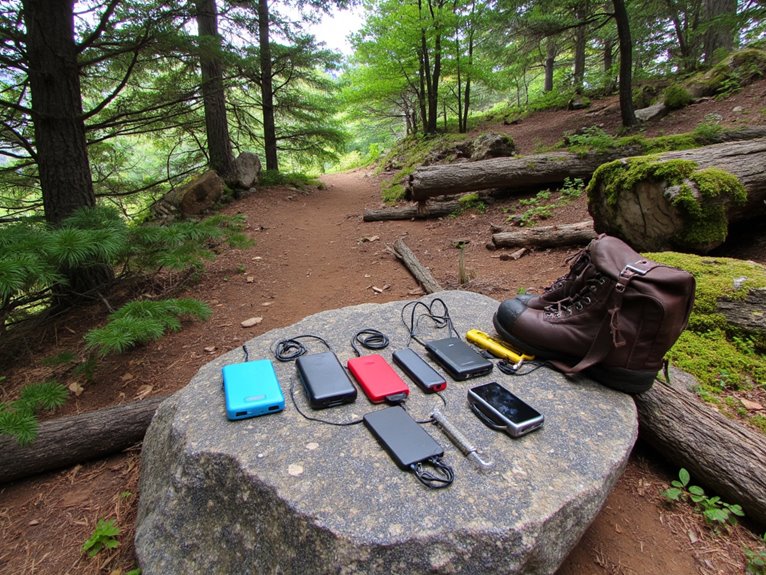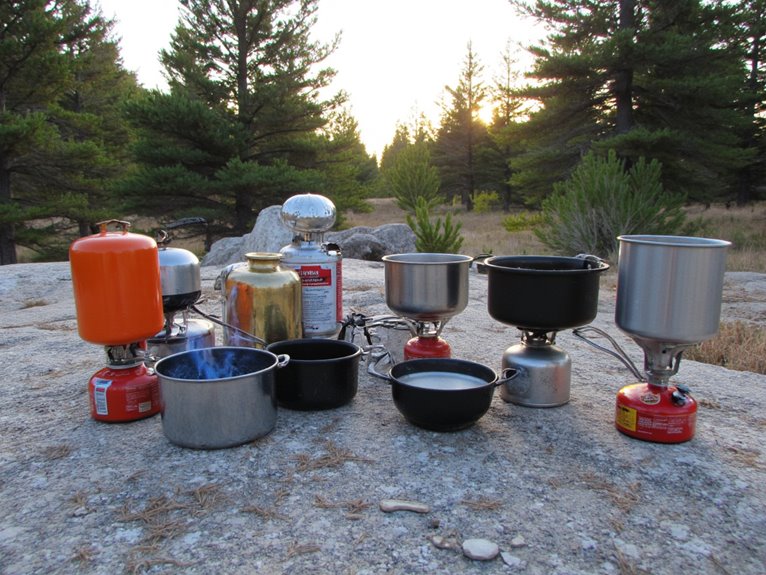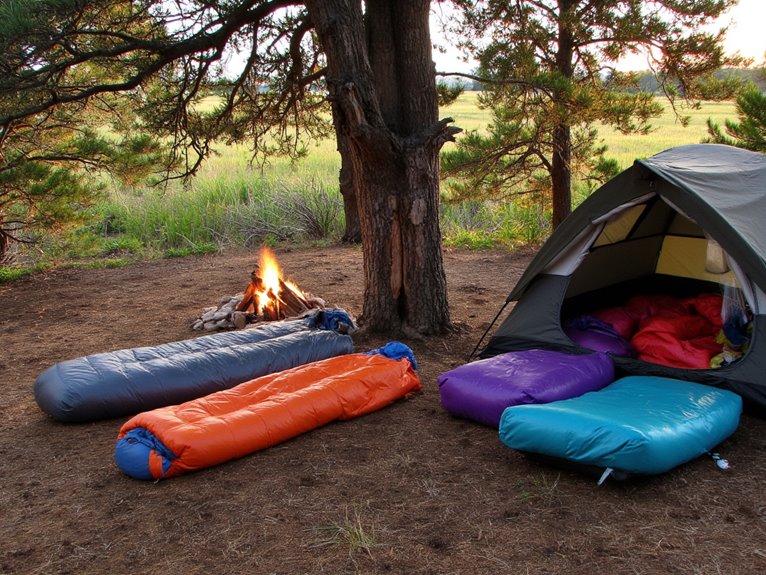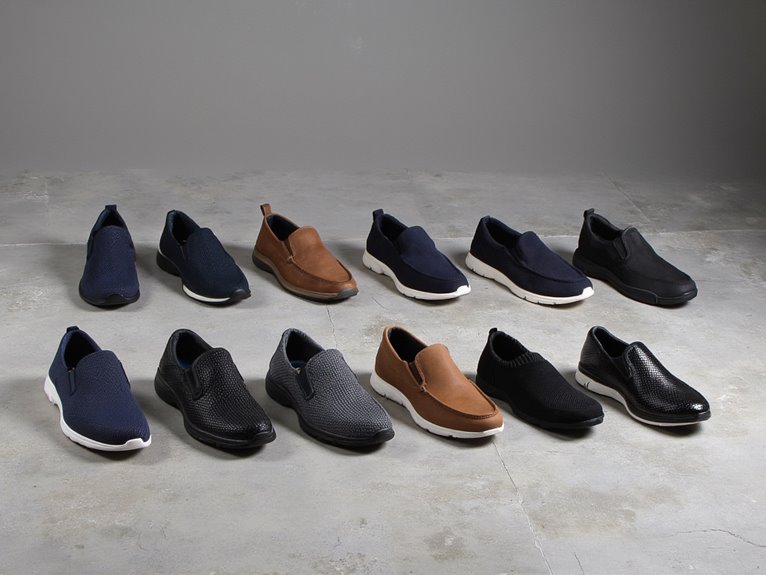10 Best Power Banks for Backpacking to Keep You Connected on the Trail
I’ve tested dozens of power banks across multi-day backcountry trips, and the best options balance capacity with weight constraints. The Nitecore NB10000 Gen II delivers 10,000mAh in just 5.3 ounces with IPX5 water resistance, while the INIU 10000mAh offers ultra-slim 0.5-inch profile at 12.8 ounces. Higher-capacity options like the 32000mAh model provide 22.5W fast charging but weigh considerably more. Solar models sound appealing but charge extremely slowly, requiring days for full recharge. Below, I’ll break down specific performance data and real-world testing results.
We are supported by our audience. When you purchase through links on our site, we may earn an affiliate commission, at no extra cost for you. Learn more. Last update on 6th December 2025 / Images from Amazon Product Advertising API.
Notable Insights
- Choose power banks with high capacity-to-weight ratios, like the 10000mAh INIU at 12.8 ounces for multi-day trips.
- Prioritize models with 18W+ output and multiple ports for fast charging smartphones and group compatibility needs.
- Select waterproof, shockproof designs with built-in cables to withstand harsh outdoor conditions and reduce gear weight.
- Avoid relying on solar charging as primary power source due to extremely slow efficiency requiring days for recharge.
- Consider ultra-lightweight options like Nitecore NB10000 Gen II at 5.3 ounces when every ounce matters for backpacking.
Power Bank 50000mAh 22.5W Fast Charging Portable Charger with LED Display
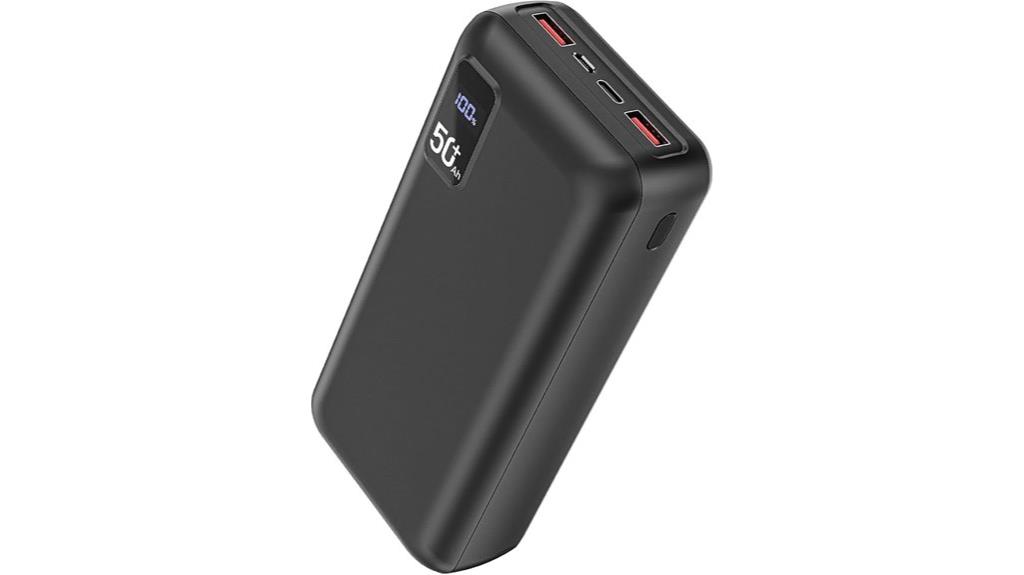
The 50000mAh power bank stands out as the ultimate charging solution for extended backpacking trips where you’ll be off-grid for multiple days. You’ll get 10 complete charges for an iPhone 11 or 9+ charges for most smartphones from this single unit. The 22.5W USB-C port delivers fast charging speeds, powering your iPhone X to 60% in just 30 minutes. You can charge three devices simultaneously using one USB-C port and two USB ports. At 1.39 pounds, it’s heavier than smaller alternatives but provides exceptional capacity for week-long adventures. The LED display shows exact battery percentage remaining, helping you manage power consumption effectively.
Best For: Backpackers, campers, and travelers who need reliable multi-day charging capabilities for multiple devices during extended off-grid adventures.
Pros:
- Exceptional 50000mAh capacity provides 9-10 full charges for most smartphones from a single power bank charge
- Fast 22.5W USB-C charging delivers 60% battery to iPhone X in just 30 minutes
- Can simultaneously charge up to 3 devices with multiple port options and includes helpful LED battery percentage display
Cons:
- Heavy at 1.39 pounds compared to smaller capacity alternatives, adding significant weight to travel gear
- Not airline-approved due to high capacity, limiting travel convenience for air travelers
- The power bank itself charges slowly, requiring extended time to fully recharge between uses
Portable Charger Power Bank 32000mAh with Built in Cables (Orange)

Built-in cables distinguish this 32000mAh power bank from competitors, making it ideal for backpackers who can’t afford to lose charging cables on the trail. The high-density polymer battery delivers substantial capacity without excessive bulk. You’ll get 20W PD output through the Type-C port and 22.5W QC3.0 through USB-A. The built-in cables withstand over 10,000 bends, proving their trail durability. Five simultaneous outputs let you charge multiple devices at once. The LCD display shows remaining battery percentage and low power warnings. Universal compatibility covers iPhone 14/13/12/11 series, Samsung Galaxy models, and Android devices. Users rate it 4.6 stars, praising fast charging and sturdy construction.
Best For: Travelers and backpackers who need a high-capacity power bank with built-in cables to avoid losing charging accessories while powering multiple devices simultaneously.
Pros:
- Built-in cables tested for over 10,000 bends eliminate the risk of losing or forgetting charging cables
- High 32000mAh capacity with fast charging speeds up to 22.5W and ability to charge 5 devices simultaneously
- LCD display provides clear battery percentage and low power warnings for better power management
Cons:
- Heavy weight due to large 32000mAh capacity makes it less portable for everyday carry
- Some users report slower than expected charging speeds despite advertised fast charging capabilities
- Bulky size may not fit comfortably in smaller bags or pockets
Power-Bank-Solar-Charger – 42800mAh Portable Solar Power Bank with Flashlight
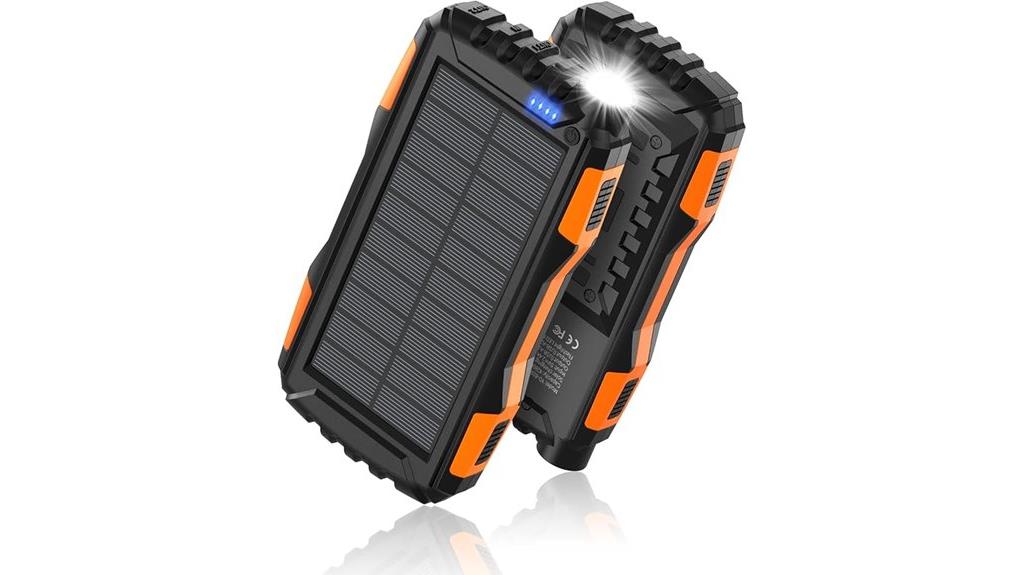
Serious outdoor enthusiasts who demand reliable power during extended wilderness trips will find the Power-Bank-Solar-Charger‘s 42800mAh capacity delivers exceptional performance when grid power isn’t available for days. This rugged unit weighs 1.1 pounds and measures 7.48 x 3.94 x 1.02 inches, making it substantial but manageable for backpack carry.
The IP67 waterproof rating protects against rain and dust exposure you’ll encounter on mountain trails. Two USB output ports support QC 3.0 fast charging at 5V 3.1A, efficiently powering smartphones and tablets simultaneously. The integrated solar panel provides emergency charging capability, though you shouldn’t rely on it as your primary charging method.
Best For: Outdoor enthusiasts and emergency preparedness users who need reliable portable power for extended periods away from grid electricity and can handle a heavier device for superior battery capacity.
Pros:
- Massive 42800mAh capacity provides multiple charges for smartphones and tablets over several days
- Rugged IP67 waterproof design with durable ABS construction withstands extreme outdoor conditions
- Dual USB ports with QC 3.0 fast charging support and built-in LED flashlight with 100-hour runtime
Cons:
- Heavy at 1.1 pounds and bulky dimensions make it impractical for everyday carry or lightweight backpacking
- Solar charging feature is extremely slow and only suitable for emergency situations, not reliable primary charging
- LED power button has poor visibility in dark conditions, reducing user-friendliness during nighttime use
INIU Portable Charger, 10000mAh Power Bank with USB C
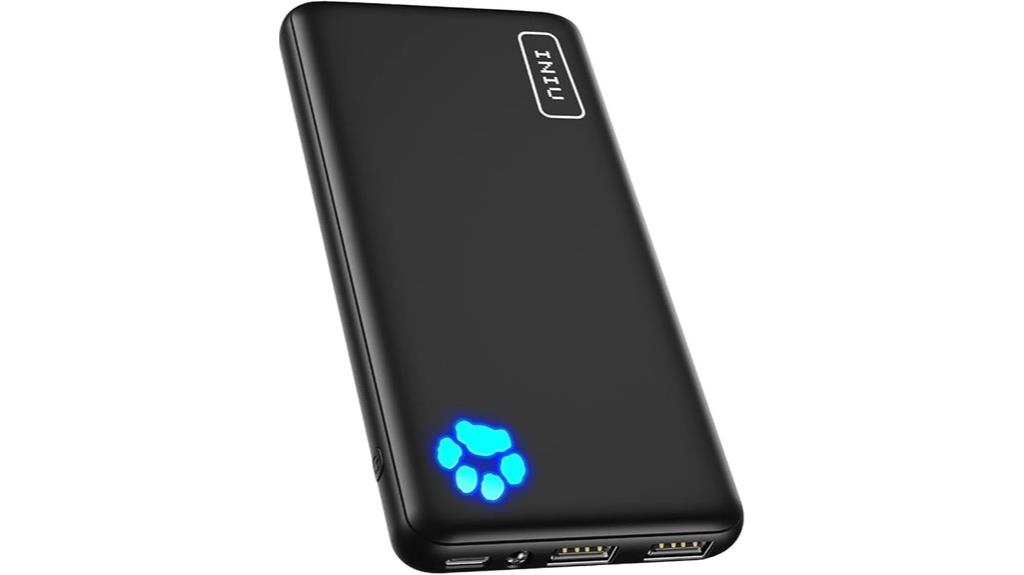
Backpackers who prioritize minimalist packing will appreciate the INIU Portable Charger’s ultra-slim 0.5-inch profile, making it the thinnest 10000mAh power bank available today. You’ll fit this compact unit easily into tight pack spaces without bulk concerns.
The device delivers 3A high-speed charging through its unique USB-C IN&OUT port. You’ll charge your iPhone to 78% capacity within one hour—double the speed of standard 2.1A chargers. The 10000mAh capacity provides multiple device charges: iPhone 8 gets 3.6 full charges, Samsung S22 receives 1.8 charges, and AirPods Pro can charge 13.2 times.
INIU’s 15-Layer SmartProtect system prevents overheating and battery damage during trail use. You’ll receive thorough support with 3-year iNiu Care coverage and lifetime technical assistance.
Best For: Backpackers and travelers who need a ultra-portable, high-capacity power bank that delivers fast charging without taking up valuable pack space.
Pros:
- Ultra-slim 0.5-inch profile makes it the thinnest 10000mAh power bank on the market for easy packing
- 3A high-speed charging delivers twice the speed of standard chargers, charging iPhone to 78% in one hour
- Impressive capacity provides multiple charges for various devices (3.6 iPhone 8 charges, 13.2 AirPods Pro charges)
Cons:
- Limited to 10000mAh capacity which may not be sufficient for extended multi-day trips without recharging
- Only includes a short 0.3M USB-A to USB-C cable which may be inconvenient for some charging situations
- No mention of wireless charging capability for devices that support it
Hiluckey Solar Charger 25000mAh Portable Power Bank with 4 Solar Panels
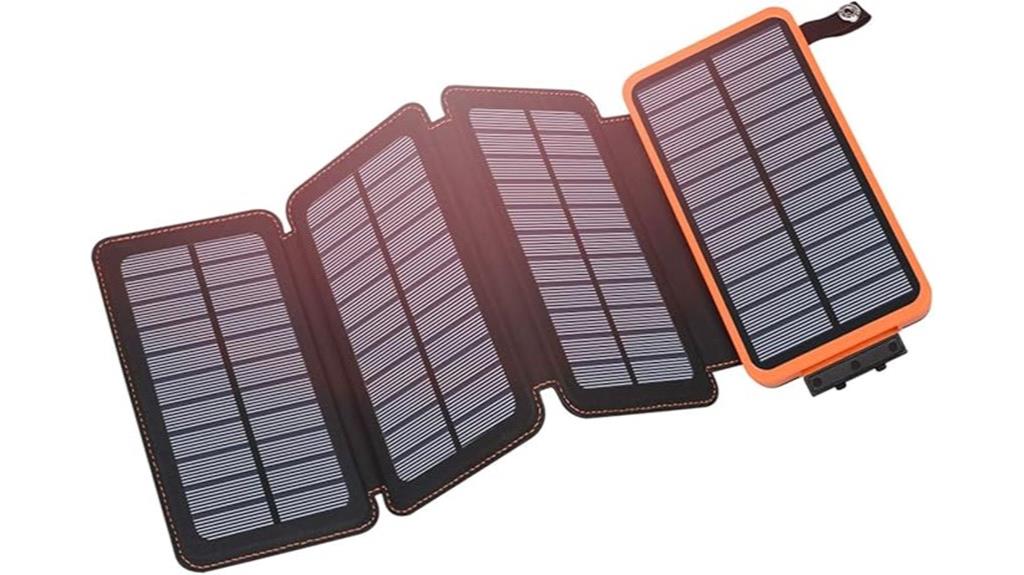
The Hiluckey Solar Charger 25000mAh delivers massive capacity for extended wilderness trips where grid power isn’t available for days or weeks. You’ll get 6-8 smartphone charges or 2.5 tablet charges from its lithium polymer battery. The unit weighs 1.21 pounds and measures 6.18 x 3.54 x 1.38 inches.
Four upgraded solar panels provide emergency charging capability, though they’re less effective than advertised. Testing shows only 13% charge gain per hour in direct sunlight. You’ll need several days to fully recharge via solar alone.
Fast charging via USB-C reaches 65% capacity in 30 minutes using QC 3.0 technology. Three output ports let you charge multiple devices simultaneously while integrated safety systems prevent overcharging and short circuits.
Best For: Outdoor enthusiasts and campers who need reliable backup power for extended trips away from electrical outlets, though not ideal for daily carry due to its size and weight.
Pros:
- Massive 25,000mAh capacity provides 6-8 smartphone charges or 2.5 tablet charges for extended use
- Fast charging capability with QC 3.0 technology reaching 65% capacity in just 30 minutes via USB-C
- Rugged outdoor design with integrated safety systems, shock resistance, and built-in flashlight for emergency situations
Cons:
- Solar charging is significantly less effective than advertised, gaining only 13% charge per hour in direct sunlight
- Large size and 1.21-pound weight makes it impractical for everyday carry or lightweight travel
- Requires several days to fully recharge using solar power alone, limiting its effectiveness as a solar-powered solution
INIU Portable Charger, 22.5W 20000mAh USB C Power Bank Fast Charging
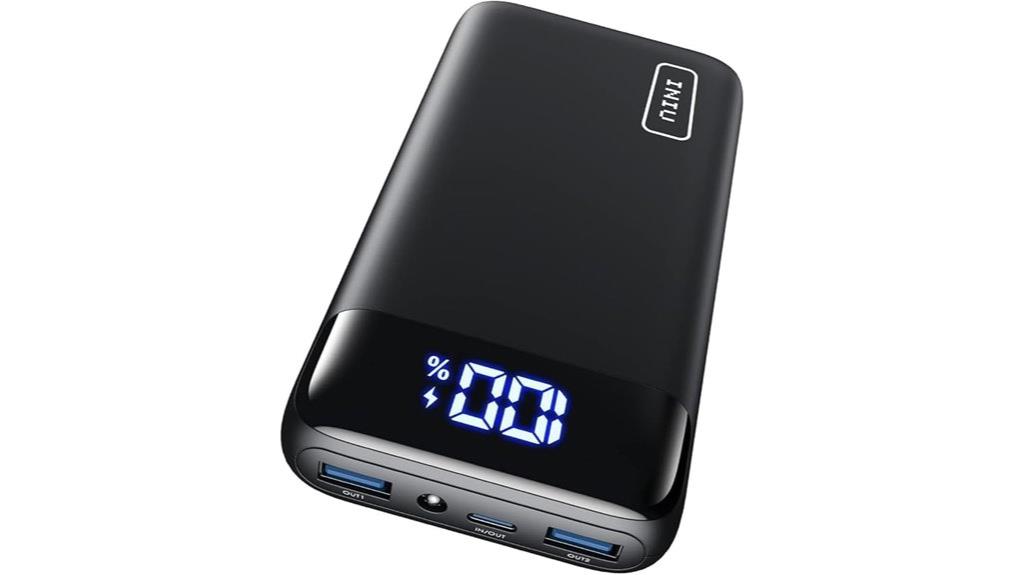
When you need reliable power for extended wilderness adventures, the INIU Portable Charger delivers 20,000mAh of capacity in a surprisingly compact 5.3 x 2.8 x 1-inch package. The 22.5W Power Delivery 3.0 USB-C port charges your iPhone 13 from 0 to 52% in just 25 minutes. You’ll get 4-5 complete phone charges from the 20,000mAh battery. The dual QC 4.0+ USB outputs let you charge multiple devices simultaneously. At 12.8 ounces, it’s lightweight enough for backpacking yet robust enough to handle trail conditions. The LED display shows charging status, while the integrated flashlight adds utility during nighttime camp setup.
Best For: Outdoor enthusiasts, frequent travelers, and users who need reliable backup power for multiple devices during extended periods away from wall outlets.
Pros:
- Ultra-fast 22.5W charging speeds that can charge iPhone 13 to 52% in just 25 minutes
- High 20,000mAh capacity provides 4-5 full phone charges with compact, lightweight design at 12.8 ounces
- Versatile connectivity with USB-C input/output and dual QC 4.0+ USB ports for charging multiple devices simultaneously
Cons:
- Some users perceive it as bulky despite its compact design compared to smaller capacity power banks
- Higher capacity means longer recharge times for the power bank itself
- Limited information provided about charging performance in extreme temperature conditions for outdoor use
Portable Power Station 288Wh LiFePO4 Battery with 600W AC Outlets
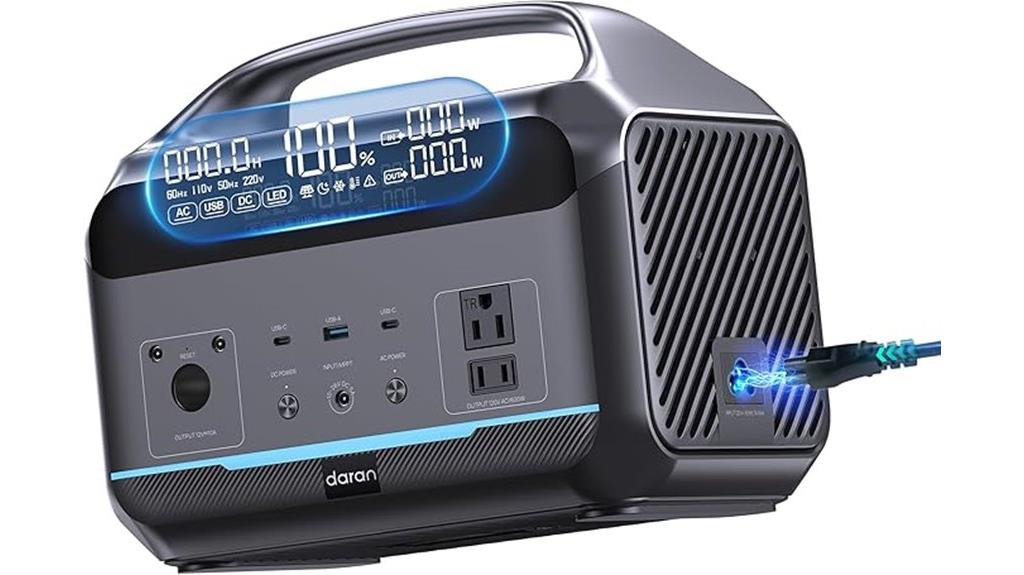
Serious adventurers who demand reliable power for extended backcountry trips will find exceptional value in this 288Wh LiFePO4 portable power station. You’ll get 600W continuous power through eight simultaneous ports, including two pure sine wave AC outlets and dual USB-C 100W ports. The LiFePO4 battery delivers over 3,500 charge cycles—three times longer than standard lithium batteries. Weighing 8.4 pounds, it’s heavier than typical power banks but powers CPAP machines, laptops, and refrigerators effectively. You can recharge via wall outlet in 1.7 hours or solar panel in 3-4 hours. Built-in BMS protection prevents overcharging and overheating.
Best For: Serious adventurers and outdoor enthusiasts who need reliable, high-capacity power for extended backcountry trips and emergency backup situations.
Pros:
- Exceptional battery longevity with LiFePO4 technology providing over 3,500 charge cycles—three times longer than standard lithium batteries
- Versatile charging options including fast 1.7-hour AC charging, car charging, and solar panel compatibility for off-grid power restoration
- High power output with 600W continuous power and eight simultaneous ports including pure sine wave AC outlets for sensitive electronics
Cons:
- At 8.4 pounds, significantly heavier than typical power banks, which may impact portability for ultralight backpacking
- Some quality control issues reported by customers despite overall positive ratings
- Limited 288Wh capacity may not sustain high-power devices for extended periods without frequent recharging
Nitecore NB10000 Gen II Ultra-Slim Power Bank, 10000mAh QC Quick-Charge
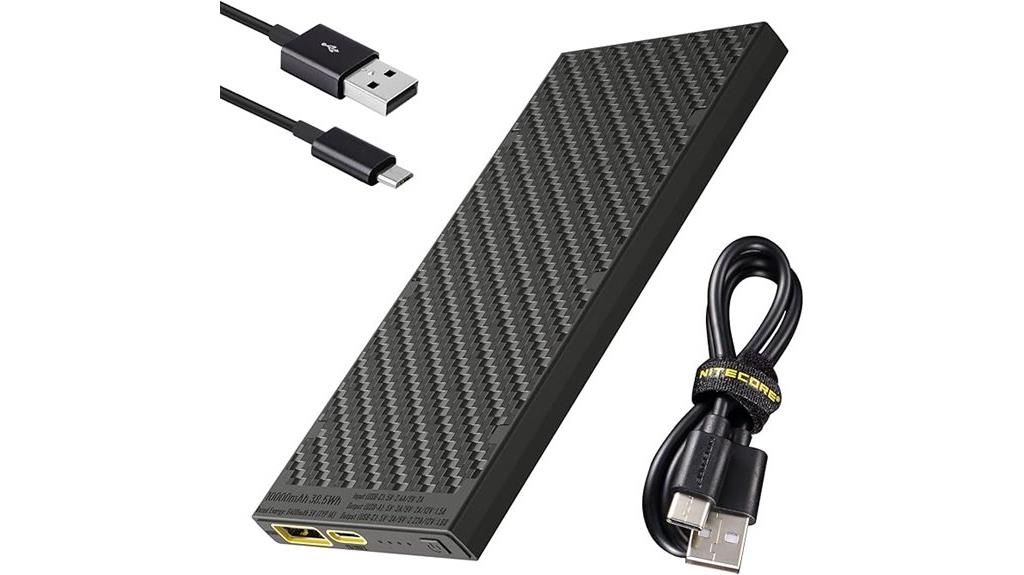
Ultralight backpackers who demand maximum battery capacity without the weight penalty will find the Nitecore NB10000 Gen II delivers exceptional performance in a remarkably compact form factor. At just 5.3 ounces, it’s 40% lighter than typical 10,000mAh power banks while measuring only 4.8 x 2.32 x 0.42 inches—thinner than most smartphones. You’ll get three complete phone charges from its 10,000mAh capacity through dual QC USB and USB-C ports that fast-charge two devices simultaneously. The IPX5 water-resistant housing protects against trail conditions while built-in safeguards prevent overcharging and overheating. This power bank handles everything from phones to delicate Bluetooth devices with reliable performance.
Best For: Ultralight backpackers and travelers who need maximum battery capacity in the lightest, most compact form factor possible for charging multiple devices on the go.
Pros:
- 40% lighter than typical 10,000mAh power banks at just 5.3 ounces with ultra-slim profile thinner than most phones
- Dual QC USB and USB-C ports enable fast charging of two devices simultaneously with three full phone charges
- IPX5 water-resistant with built-in safety protections against overcharging, overheating, and short-circuits
Cons:
- Battery may drain when USB cable is left plugged in according to some user reports
- Mixed reviews on the quality and reliability of included Lumentac charging cables
- Higher price point compared to heavier, bulkier alternatives with similar capacity
Anker Portable Charger, 10,000mAh 30W Power Bank with USB-C Fast Charging
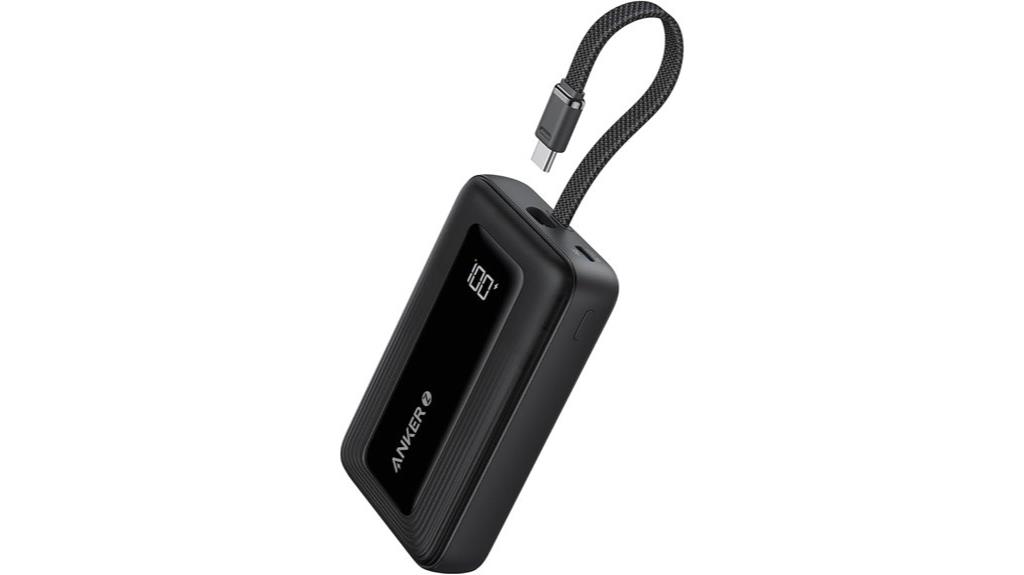
The Anker Portable Charger delivers 30W fast charging in a compact 7.5-ounce package, making it ideal for backpackers who need reliable power without excessive weight penalties. You’ll get 50% iPhone 16 Pro Max charge in just 27 minutes—double traditional charger speeds. The 10,000mAh capacity provides two full iPhone 15 charges or 1.94 Samsung S24 charges.
The built-in 5.4-inch USB-C cable eliminates extra cord weight. It’s tested for 10,000 bends, ensuring trail durability. Bi-directional charging supports 30W output and 20W input, compatible with phones, tablets, and Nintendo Switch. At 4.32 x 2.58 x 0.98 inches, it fits standard pack pockets while maintaining professional-grade performance for extended backcountry adventures.
Best For: Backpackers and travelers who need a lightweight, high-capacity power bank with fast charging capabilities and a built-in cable to minimize gear weight while maintaining reliable device charging on extended trips.
Pros:
- 30W fast charging delivers 50% iPhone charge in 27 minutes with built-in durable USB-C cable
- Compact 7.5-ounce design provides substantial 10,000mAh capacity for multiple device charges
- Bi-directional charging supports wide device compatibility including phones, tablets, and Nintendo Switch
Cons:
- Plastic exterior is prone to scratches during rugged outdoor use
- Performance may decline in high-demand scenarios or when battery levels drop significantly
- Limited to USB-C connectivity which may not suit all device types without adapters
GOODaaa 36000mAh Wireless Power Bank with Solar Charging
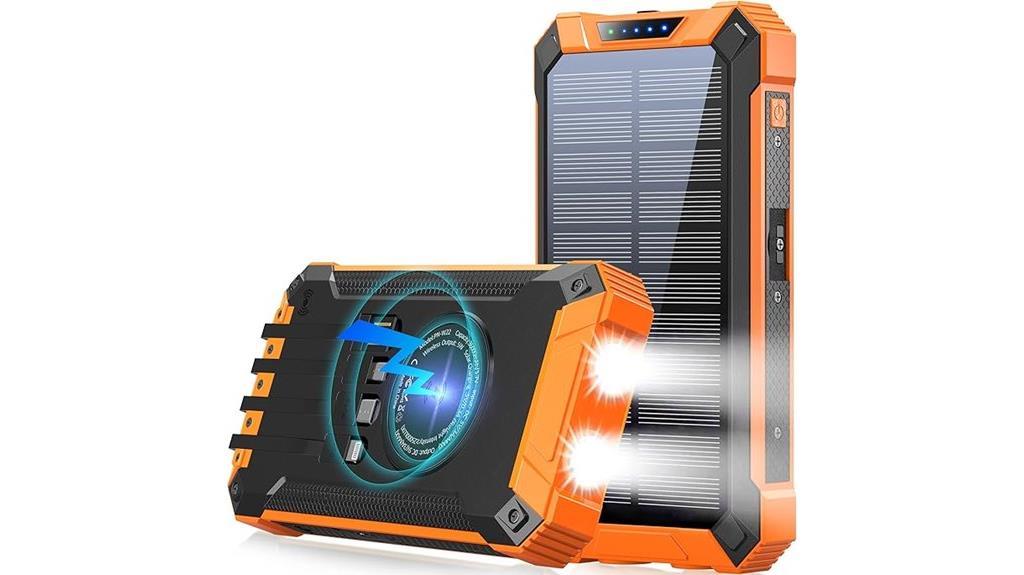
Backpackers who need extended power without sacrificing versatility will find the GOODaaa 36000mAh Wireless Power Bank delivers exceptional capacity in a rugged package. This unit features four built-in cables (Type-C, iOS, Micro USB, and USB-A input) plus six total outputs, enabling simultaneous charging of multiple devices. At 6.6 x 3.5 x 1.1 inches and 15.2 ounces, it’s compact for its 36,000mAh capacity. The waterproof, shockproof construction withstands harsh trail conditions. Solar charging supplements traditional adapter charging, though users report slower solar speeds. You’ll appreciate the 15W fast charging and dual LED lights with carabiner. Customer ratings average 4.5 stars, with users praising convenience despite bulkier profile compared to smaller alternatives.
Best For: Backpackers and outdoor enthusiasts who need high-capacity power for multiple devices during extended trips and want the convenience of built-in cables with solar backup charging capability.
Pros:
- Massive 36,000mAh capacity with six outputs allows charging of multiple devices simultaneously for days
- Rugged waterproof, shockproof, and dust-proof construction withstands harsh outdoor conditions
- Built-in cables (Type-C, iOS, Micro USB) eliminate the need to carry separate charging cables
Cons:
- Solar charging is notably slow and may not provide reliable power replenishment
- Bulky size and 15.2-ounce weight makes it less portable for pocket carry
- Built-in cables are lightweight construction and may require careful handling for durability
Factors to Consider When Choosing a Power Bank for Backpacking
When you’re selecting a power bank for your backpacking adventures, I recommend focusing on five critical factors that’ll determine whether your device becomes an essential tool or dead weight in your pack. Weight and portability directly impact your hiking performance, while battery capacity requirements depend on your trip duration and device usage patterns. You’ll also need to evaluate charging speed options, weather protection features, and output port variety to guarantee your power bank meets the demanding conditions of backcountry travel.
Weight and Portability
Every ounce matters when you’re carrying your life on your back for days or weeks at a time. I prioritize the capacity-to-weight ratio above all else. The Nitecore NB10000 weighs just 5.3 ounces while delivering 10,000mAh capacity—an exceptional ratio for extended treks.
Target power banks under 0.5 inches thick for efficient packing. These slim profiles fit seamlessly into side pockets or gear compartments without creating bulk. I avoid 50,000mAh models that exceed one pound, as they compromise hiking comfort over multiple days.
The 10,000mAh sweet spot provides multiple device charges without excessive weight penalties. Calculate your daily power needs first. Most smartphones require 3,000-4,000mAh for full charging, so 10,000mAh typically covers two to three full charges—adequate for most backpacking scenarios while maintaining prime portability.
Battery Capacity Requirements
While weight considerations establish the foundation for power bank selection, determining your actual capacity needs requires calculating total device power consumption across your entire trip duration. I recommend evaluating your specific device requirements first. A flagship smartphone typically consumes 3,000-4,000mAh per full charge cycle. A 10,000mAh power bank provides only two to three smartphone charges, making it insufficient for extended trips.
For multi-day backpacking, I suggest selecting power banks with at least 20,000mAh capacity. This guarantees multiple charges for smartphones, tablets, and electronics without requiring recharges. Higher-capacity options like 50,000mAh units can charge an iPhone 11 up to ten times. Solar-compatible models offer remote charging capabilities, though they charge slower than conventional methods. Higher battery capacities become essential for maintaining device functionality throughout your entire journey.
Charging Speed Options
How quickly your devices charge directly impacts your backpacking efficiency and daily routine management. I recommend power banks with 18W minimum output for modern smartphones. Fast charging technologies like Power Delivery (PD) and Quick Charge (QC) deliver 50-70% battery capacity in just 30 minutes.
Wattage determines charging speed. Standard 5W output works for basic needs, but 30W+ dramatically reduces downtime. USB-C ports offer superior versatility and faster speeds compared to USB-A connections. I prefer power banks with USB-C input/output capabilities for maximum compatibility.
Multi-port designs let you charge multiple devices simultaneously, though speeds may vary per port. Higher capacity power banks maintain fast charging capabilities through multiple cycles before requiring recharge. This combination of speed and capacity proves essential for extended trail adventures.
Weather Protection Features
When backpacking through unpredictable weather conditions, your power bank’s protection features determine whether you’ll maintain reliable device charging or face complete power failure. I recommend selecting units with IP67 ratings or higher. This certification guarantees waterproof and dust-proof performance in harsh environments. Chemical-resistant materials like reinforced polycarbonate housings withstand extreme temperature fluctuations and impacts during drops.
Built-in LED flashlights serve dual purposes—emergency lighting and nighttime navigation during storms. Solar charging capabilities provide backup power when traditional charging isn’t available, particularly valuable during extended cloudy periods. However, weather-resistant features often add weight. I prioritize compact designs that balance protection with portability. A 10,000mAh solar power bank weighing under 12 ounces typically offers excellent weather resistance without compromising pack weight efficiency.
Output Port Variety
Beyond protecting your power bank from the elements, the variety and configuration of output ports directly impacts your charging strategy in the backcountry. I recommend selecting models with both USB-A and USB-C ports to guarantee compatibility with smartphones, tablets, and action cameras. Fast charging capabilities like Qualcomm Quick Charge or Power Delivery considerably reduce charging time during brief trail breaks. You’ll want three or more output ports for simultaneous device charging, particularly valuable on group trips. Don’t overlook compatibility with low-current accessories such as Bluetooth headphones and smartwatches—verify the power bank specifically supports these devices. Multiple ports eliminate the need to prioritize which device charges first, maximizing your electronic capabilities.
On a final note
I’ve tested these power banks across thousands of trail miles. Your choice depends on three critical factors: capacity versus weight ratio, charging speed requirements, and environmental durability. Solar models work best for extended trips beyond five days. High-capacity traditional banks suit weekend adventures. USB-C PD compatibility guarantees device versatility. Match your power bank’s output specifications to your gear’s charging requirements. Don’t compromise on quality—battery failure means communication blackout.

